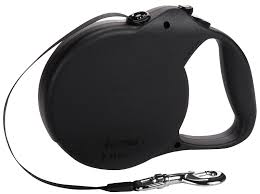I posted this in 2015, and have had several conversations about this product recently. I have forwarded this post to several clients within the last two months. I thought it worth re-posting for that reason. Hope you learn from it, and decide to share.
Retractable leashes are very popular. They are on many lists of “top tens”, and “must haves” for dog owners. This is an example of why all lists are not created equal. Question the source, because I can guarantee you that these leashes are on no must have lists written by veterinarians. I really dislike them, and don’t have any colleagues that like them either. In case you aren’t familiar with them, they are leashes consisting of a long, thin cord on a reel, not unlike a fisherman’s reel. They range in length and size, and you would be selecting one based on your dog’s size and weight. The longest is up to 26 feet long! This is a selling point, in fact. They claim that you can allow your dog to roam and exercise, yet still be under your control, all while you can see them. And by clicking the brake button with your thumb, you can reign them in a few feet at a time, when wanted. Sounds good in theory, right.
The problem is…, well there are countless problems, actually. To say that I loathe these leashes is an understatement. Many people and pets have been sent to the hospital because these leashes are rarely able to realistically help you control your animal. And I say this because I have personal experience with it, and was in fact sent to a hospital because of injuries sustained while using it. Even if your dog weighs less than 6 pounds, there is no reason that anyone should own one of these. I cringe whenever I see, in particular, an elderly couple walk in with one. And the larger the dog, even worse. Here’s why:
1. Retractable leashes almost always teach a dog to pull. Dogs want to walk faster than you while on a walk. With these leashes he can pull, and you may let out a foot or two to allow him to walk ahead. So you have just rewarded him for an undesirable behavior (pulling on the lead). Rewarding the behavior will lead to it being repeated. Strike one.
2. A dog 10 feet away from you, for example, on a walk, is not under control, whether they are on a leash or not. If there is any chance, say, of a scuffle between him and another dog, you will need to reel him in to be able to remove both of you from the situation. Things happen quickly, and often too quickly for you to intervene in time. Also, they can dart into traffic and get hit by a car. They can get tangled in the leash, leading to injuries. They can also tangle you in their cord, potentially causing you to be knocked down, or dragged. This happened to me, so quickly I can’t even believe it happened. My head was turned one way, while my 90 lb Labrador got spooked and darted in the other direction. He pulled the full 25 feet of the leash before my thumb was able to intervene in breaking. It sent me airborne, until I landed, face down on the pavement where I was further dragged another 5 feet or so until momentum finally gave out and I mercifully came to a stop. But, that was well after I scuffed most of my exposed body and nearly broke my arm. It’s quite simple physics actually. This was 25 years ago, when I was much less wise, and my hips were even more resistant to breaking. Thus, the cringing when I see elderly clients holding one. I have been known to try to replace them, on the spot, during exams. I am not joking. Strike two.

3. Back to the retractable cord itself. It is a hazard, in that it commonly causes friction burns or “rope burns”. Human hands and doggie mouths and tongues are often casualties caught in the crossfire when retracted quickly. There are even multiple reports of finger amputations when the cord was wrapped around a finger while being quickly retracted when their pet took off suddenly, without notice. Think it can’t happen? Think again. Has your dog even sped off to chase a squirrel, deer, or another dog. Now imagine your index finger being wrapped by the cord, and imagine how that would feel. Strike three.
4. And, the reel and handle part of the leash can be heavy, and the unit can be easily dropped. In the scenario above, imagine that when your dog, with his 10 foot lead, suddenly bolts while you are daydreaming, and you drop the leash. You now have your dog running, while the leash is retracting, and “chasing” him, for all he knows, down the street. This will frighten him and likely cause him to run further away from it, and you, ignoring your yells to come back. Dogs get lost, hit by cars, etc. Strike four, in case you needed an extra reason to not buy one.
So, I know that I will not be getting any fan letters from the manufacturers of these leashes. Oh well. If you take my advice and never buy one, this post will have served its purpose.
Dr. Dawn
Please share and subscribe here








